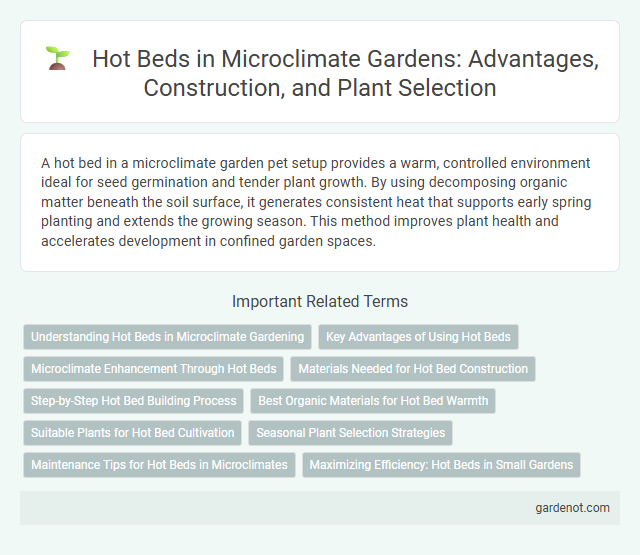A hot bed in a microclimate garden pet setup provides a warm, controlled environment ideal for seed germination and tender plant growth. By using decomposing organic matter beneath the soil surface, it generates consistent heat that supports early spring planting and extends the growing season. This method improves plant health and accelerates development in confined garden spaces.
Understanding Hot Beds in Microclimate Gardening
Hot beds are essential components of microclimate gardening, leveraging decomposing organic matter to generate heat that extends the growing season. This technique creates a warm, protected environment ideal for starting seedlings and tender plants in cooler climates. By maintaining higher soil temperatures, hot beds promote faster germination and robust plant growth within controlled microclimates.
Key Advantages of Using Hot Beds
Hot beds enhance microclimate conditions by providing consistent warmth, accelerating seed germination and plant growth even in cooler seasons. They reduce frost risk by maintaining higher soil temperatures, extending the growing season for sensitive plants. Efficient use of organic materials in hot beds also promotes sustainable heat generation without additional energy costs.
Microclimate Enhancement Through Hot Beds
Hot beds significantly enhance microclimates by generating consistent warmth through decomposing organic matter, extending the growing season for sensitive plants. This elevated soil temperature improves seed germination rates and promotes vigorous root development, creating an ideal environment for early crops. Effective hot bed management ensures stable heat output, optimizing plant growth and microclimate control in garden settings.
Materials Needed for Hot Bed Construction
Constructing a hot bed requires materials such as a sturdy frame made of untreated wood or bricks, organic compost or manure to generate heat, and a layer of straw or mulch to insulate the bed. A transparent cover, like glass or clear plastic, helps trap warmth and maintain a stable microclimate for seed germination and plant growth. Proper drainage materials, such as coarse sand or gravel, can also be essential to prevent waterlogging and promote healthy root development.
Step-by-Step Hot Bed Building Process
Constructing a hot bed begins by selecting a sunny location and digging a shallow trench approximately 18 inches deep and twice as wide as the intended bed. Next, layer fresh manure at the bottom to generate heat through decomposition, followed by a 4-6 inch layer of garden soil or compost for planting. Cover the bed with a wooden frame and clear plastic or glass to trap warmth, creating an ideal microclimate for seed germination and early plant growth.
Best Organic Materials for Hot Bed Warmth
Peat moss, well-rotted manure, and composted straw are the best organic materials for hot bed warmth due to their high nitrogen content and heat-generating decomposition process. Layering these materials ensures consistent heat retention essential for seed germination and early plant growth in a microclimate garden setup. Incorporating wood chips can enhance aeration while maintaining an optimal temperature for extended periods.
Suitable Plants for Hot Bed Cultivation
Hot beds provide an ideal microclimate for heat-loving plants such as tomatoes, peppers, and eggplants by maintaining consistent soil warmth and moisture. Leafy greens like spinach and lettuce also thrive in hot beds, benefiting from the extended growing season and protection from frost. Root vegetables, including radishes and carrots, can be successfully cultivated in hot beds due to the enhanced soil conditions promoting robust growth.
Seasonal Plant Selection Strategies
Hot beds in microclimate gardens optimize soil warmth, enabling early-season planting of heat-loving crops like tomatoes, peppers, and eggplants. Seasonal plant selection strategies prioritize cold-tolerant greens and root vegetables during cooler months, transitioning to warmth-demanding plants as soil temperatures rise. Managing crop rotation within hot beds enhances soil fertility and pest control, ensuring productive growth throughout the changing seasons.
Maintenance Tips for Hot Beds in Microclimates
Maintaining a hot bed in a microclimate requires consistent monitoring of soil moisture and temperature to ensure optimal heat retention for seed germination and plant growth. Regularly adding fresh organic materials like compost or manure replenishes nutrients and sustains microbial activity essential for heat generation. Protecting the hot bed from extreme weather by using insulating covers or mulch helps maintain stable conditions, preventing temperature fluctuations that could disrupt plant development.
Maximizing Efficiency: Hot Beds in Small Gardens
Hot beds optimize small garden spaces by generating consistent warmth through decomposing organic materials, enhancing seed germination and extending growing seasons. Utilizing insulated frames and compost layers maximizes heat retention, promoting faster plant growth and higher yields. Efficient hot bed design includes sourcing rich manure and controlling moisture levels to sustain microbial activity essential for heat production.
Hot bed Infographic

 gardenot.com
gardenot.com